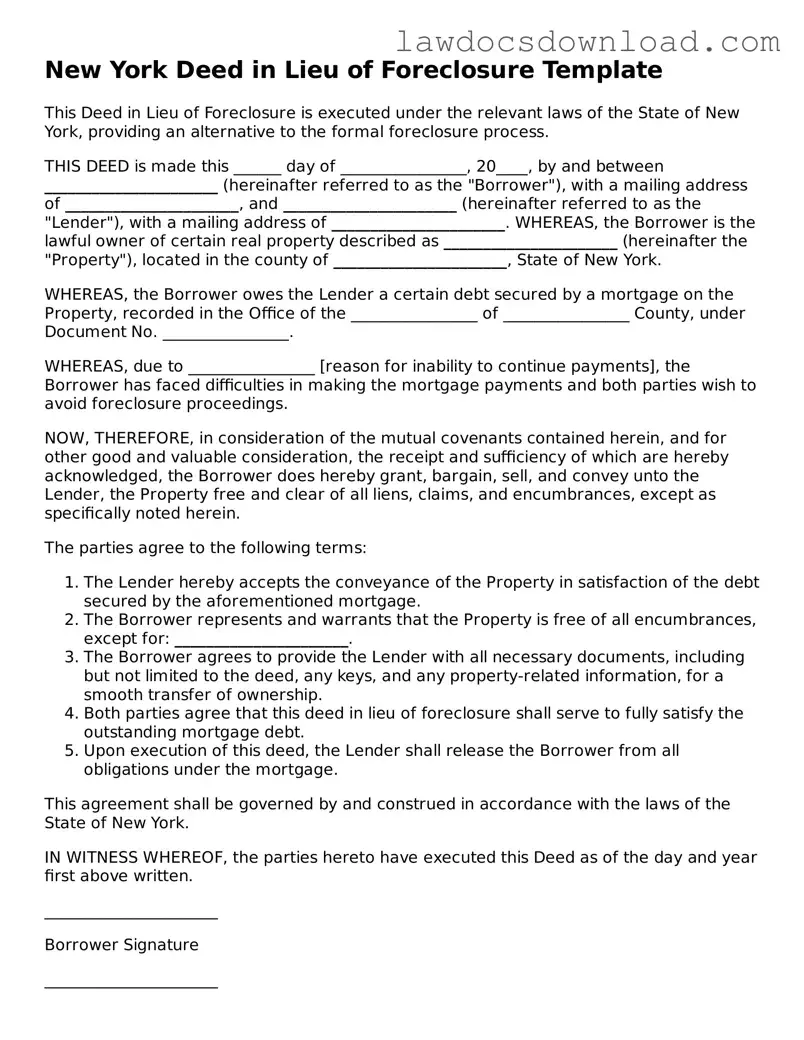New York Deed in Lieu of Foreclosure Template
This Deed in Lieu of Foreclosure is executed under the relevant laws of the State of New York, providing an alternative to the formal foreclosure process.
THIS DEED is made this ______ day of ________________, 20____, by and between ______________________ (hereinafter referred to as the "Borrower"), with a mailing address of ______________________, and ______________________ (hereinafter referred to as the "Lender"), with a mailing address of ______________________. WHEREAS, the Borrower is the lawful owner of certain real property described as ______________________ (hereinafter the "Property"), located in the county of ______________________, State of New York.
WHEREAS, the Borrower owes the Lender a certain debt secured by a mortgage on the Property, recorded in the Office of the ________________ of ________________ County, under Document No. ________________.
WHEREAS, due to ________________ [reason for inability to continue payments], the Borrower has faced difficulties in making the mortgage payments and both parties wish to avoid foreclosure proceedings.
NOW, THEREFORE, in consideration of the mutual covenants contained herein, and for other good and valuable consideration, the receipt and sufficiency of which are hereby acknowledged, the Borrower does hereby grant, bargain, sell, and convey unto the Lender, the Property free and clear of all liens, claims, and encumbrances, except as specifically noted herein.
The parties agree to the following terms:
- The Lender hereby accepts the conveyance of the Property in satisfaction of the debt secured by the aforementioned mortgage.
- The Borrower represents and warrants that the Property is free of all encumbrances, except for: ______________________.
- The Borrower agrees to provide the Lender with all necessary documents, including but not limited to the deed, any keys, and any property-related information, for a smooth transfer of ownership.
- Both parties agree that this deed in lieu of foreclosure shall serve to fully satisfy the outstanding mortgage debt.
- Upon execution of this deed, the Lender shall release the Borrower from all obligations under the mortgage.
This agreement shall be governed by and construed in accordance with the laws of the State of New York.
IN WITNESS WHEREOF, the parties hereto have executed this Deed as of the day and year first above written.
______________________
Borrower Signature
______________________
Lender Signature
STATE OF NEW YORK
COUNTY OF ________________
On this ____ day of ________________, 20____, before me, the undersigned, personally appeared ________________, known to me (or satisfactorily proven) to be the person(s) whose name(s) is/are subscribed to the within instrument and acknowledged that he/she/they executed the same for the purposes therein contained.
______________________
Notary Public
My Commission Expires: ________________
